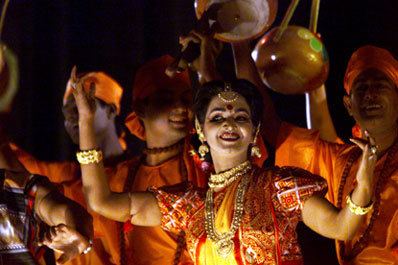 | ||
Religious music Hamd
Naat
Ghazal
Jari gan
Shreekrishna Kirtana
Shyama Sangeet Ethnic music Agamani-Vijaya
Baul
Bhatiali
Bhawaiya
Dhamail
Gombhira
Kavigan
Maimansingha Gitika
Sari gan Traditional music Rabindra Sangeet
Nazrul Geeti
Lalon
Hason Raja Music awards Shilpakala Academy Award Music festivals Dhaka World Music Festival Music media Radio
Radio Foorti
Radio Today
Radio Amar
ABC Radio
Television
Channel 9
Banglavision
NTV
Channel i
Channel 16
Internet
AmaderGaan.com | ||
Bangladeshi rock or Bangla rock (Bengali: বাংলা রক) is the rock music of Bangladesh. It originated in Chittagong with Souls, which was formed in 1970. Distortion, electric and bass guitars and drums are used, sometimes accompanied by piano or other keyboard instruments. In the past, it was accompanied by saxophone, flute, violin and bass violin.
Contents
Origin (1960s–1970s)
Bangladeshi rock began in 1960 when a handful of self-taught musicians joined to create original songs. Their efforts resulted in the birth of the Bangla rock scene. In 1963, Zinga Goshty was the first orchestra band in Bangladesh, formed in Chittagong by a group of students from Chittagong College. Pioneering groups during the late 1960s included Windy Side of Care (M. Fazle Rub, Alamgir, Rafique Mazhar Islam Saju, Rafi Omar, and Khwaja Shabbir Quader), the Lightnings (Neo Mendis,Noel Mendis) Rambling Stones (Zafar Iqbal and others), Ugly Phases, Time Ago Motion (Robin and others), Fire in Ice (Selim Alam, Reza Ahmed, Chhoton Islam and Habib Zafarullah Mithu) and Insex Dui (a band with American students studying at the American School in Dacca). They performed without expensive instruments or sound systems.
Azam Khan (Uchharon), a.k.a. the Legend, a.k.a. the Imaginative Composer, emerged during the 1970s. Happy Akhand's "Abar Alo Elo Je Shondha" was a popular song, and his premature death was a blow to the musicians he influenced. Akhand's contemporaries include the late Firoze Shahi, Ferdaus Wahid and Fakir Alamgir. Many old bands are still active, including Souls (1970), Feedback (1976), Miles (1978), Nagar Baul (1980) and Warfaze (1984).
1980s
Although early Bangladeshi rock is characterised by romantic songs and mellow tunes, the scene began to change during the 1980s. Waves introduced Heavy Metal music in Bangladesh. Warfaze was also a progressive band during this period. Feedback was another band, who released the albums Ullash and Mela. From the mid 1980s to the early 1990s, hard rock became more popular. "It was around 1986 when Miles performed hard rock in Dhaka. They performed songs of Iron Maiden which was rocking to people. The next concert was a mind blowing performance, in which they covered several numbers of Iron Maiden and they did very well indeed!" The band was called Rock Strata, and it was followed by Warfaze. Different Touch was also active during the late 1980s and early 1990s, playing "Sraboner Meghgulo". Nova (1986) and Renaissance were bands from the same period. The era also witnessed the emergence of artists such as Ayub Bachchu (who created LRB) and solo performers Tapan Chowdhury and Kumar Bishwajit.
1990s
The early 1990s was arguably the most productive phase of Bangladeshi rock, featuring bands such as LRB and Ark. Cryptic Fate and Maqsood O Dhaka were other notable groups from the era.
The heavy-metal scene further developed during the early 1990s. "Mixed album Hooray was, back then, a huge inspiration and boost for many celebrated bands from today", said Shakib of Cryptic Fate. Warfaze and Rock Strata also released albums. Another band was Winning, which later disbanded. That year metal bands such as Cryptic Fate, Mysteria, Dethrow and PsychoDeth also emerged, playing at underground shows. Shironaamhin, formed in 1996, is still active as of 2013. Around 1998, Koprophilia, Clovermind and Spanking Monkeys began playing alternative music. After a period of turmoil, around 1999 Artcell (formerly Tantrik), Metal Maze, Migraine, Black, Wire, and Nemesis surfaced.
2000s
By the early ears of the 21st century, bands such as Aurthohin, Dalchhut, Shironamhin, Black, Artcell, Poizon Green, Kronic, Reborn, Scarecrow and Nemesis became active on the Bangladeshi music scene with the release of debut albums and songs. Newer bands emerging during this period, such as Stentorian, Arbovirus, Shunno and Lalon, also became established. The era also saw the revival of the Chittagong rock-music scene. Although the city is considered the birthplace of Bangladeshi rock it declined during the 1990s, when most local musicians and bands began moving to Dhaka for more opportunity and better facilities. During the early 2010s, the Bangladesh Music Bands Association (BAMBA) and the Chittagong Musical Band Association (CMBA) began organising rock concerts in the city, which gave exposure to local underground bands. This resulted to the emergence of new rock bands in the city, such as Hemorrhage and Blunderware.
